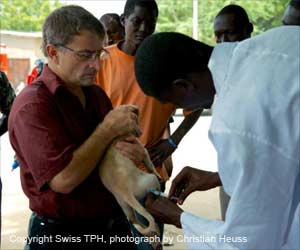A bio-mathematical method helps prove that rabies can be eliminated in Africa, as it is not a technical problem. However, with political will and sufficient financial resources, it is possible to eradicate rabies in Africa.

‘Poorest countries in Africa and Asia can eliminate human rabies through mass vaccination of dogs, additional funding and a concerted political will.’





The study employed a bio-mathematical method for estimating the transmission dynamics of rabies. Rabies is a viral disease that kills tens of thousands of people every year, predominantly in Africa and Asia. The disease is transmitted through the bites of infected dogs and foxes (read the disease fact sheet concerning rabies).
In West and Central Europe, rabies was eliminated some 20 years ago. Switzerland was declared free of rabies in 1999 after implementing a strategy targeting foxes.
"If you want to prevent humans from dying from rabies in Africa and Asia, you need to eliminate dog rabies," said Jakob Zinsstag from the Swiss Tropical and Public Health Institute (Swiss TPH), first author and principal investigator of a study in Science Translational Medicine.
Swiss TPH, together with collaborators in Europe and in Africa (including support from the Institut Pasteur in Paris, France, and ETH Zurich in Basel, Switzerland, for genetic analyzes of collected rabies viruses), demonstrated the proof-of-concept that elimination of rabies is feasible.
Advertisement
What is needed next is additional funding and a concerted political will," said Zinsstag, an epidemiologist and veterinary public health expert.
Advertisement
In 2012 and 2013, 20,000 dogs were vaccinated each year against rabies. Hence, more than 65% of the city's estimated dog population participated in the intervention, "an excellent coverage rate," said Zinsstag. "We mobilized the neighborhood chiefs and they in turn mobilized the people and their dogs."
Further insights through phylodynamics
The study is one of the first research projects to apply a rigorous phylodynamic method to dog rabies, and hence, it expands upon the normative phylogenetics (i.e. assessing the genetic relatedness of virus strains) with the dynamics of transmission over time.
This made it possible to calculate the reproductive number of rabies among the dogs after the first mass dog vaccination in 2012.
"Dog rabies was likely re-introduced through the import of dogs by humans from outside N'Djamena after the rabies elimination had been achieved," Zinsstag explains. The phylogenetic analysis supports this finding, since the sequence of nucleoprotein of the new viruses showed a different genetic structure.
"The molecular method ascertained the results put forth by the mathematical model through an independent approach," said Zinsstag. "Therefore eliminating rabies is not a technical problem, but a matter of political will and sufficient financial resources."
Source-Eurekalert









